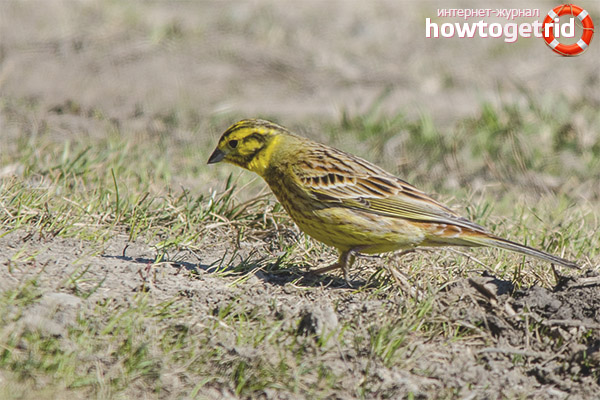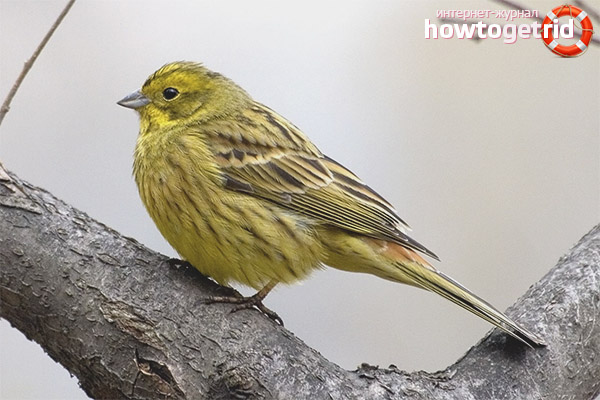The content of the article
Ordinary oatmeal refers to a bird belonging to the oatmeal family. People recognize this bird due to the beautiful yellow plumage with a golden tint on their head and chest. The individuals of the species under discussion live mainly in European and Asian countries, and they also feel great in New Zealand. It was in this country of birds that a man brought birds, later the breed took root.
Description
- By its external characteristics, the bird grows up to 18 cm with a body weight of 30 g. When the mating season begins, the male of this breed is easily recognized by its distinctive characteristics. Among them, the presence of elongated lines in the chest and goiter.
- Also, the wings are pigmented in a dark brownish tone, on the abdominal part, sternum, cheeks and head there are yellow feathers with a golden tint. The tail is elongated, the area above the tail and the lumbar are pigmented with a neutral color.
- On the cheeks there is a green-olive color pattern. The same situation is observed on the frontal section, on both sides of the head. And in the back zone, approximately a similar pattern is pigmented in dark color, chocolate or chestnut.
- Feathering females are not so bright. They are painted in a faded yellowish pigment. On the feathers there are greenish blotches, the wings are purple-red-gray. Young birds similar in coloring to females. Moreover, it does not depend on which gender the chick is assigned to.
- As for the molting season, this event falls on the autumn period. Yellowish feathers are replaced by dark ones. Birds do not lose their bright specks, they are present exclusively in the area of the peritoneum and neck. At this time, it becomes extremely difficult to identify where the individual is male and where is female.
Spread
- Feathered friends, before all other bird species, arrive from their wintering places in their native expanses. At first, males come because they are not afraid of the cold. The males begin to sing, and the snow still lies. So they make it clear that their territory, beautiful ladies will arrive soon.
- Birds are common on different continents, most of them in European countries, Siberia and Iran. They prefer to build housing for posterity in France, near the Balkan or Iberian Peninsula, and are also found on the southern side of Italy.
- From the north, the spread of birds stretches from the Kola Peninsula to Scandinavia. The birds live in Russia, Ukraine, Moldova. A separate site for the construction of nests for future offspring is considered the distance, starting from the Caucasus, ending with the Iranian mountains.
- It was previously mentioned that birds appeared in England artificially. That is, they were specially transported here to New Zealand. At that time, these territories boasted a large number of forage crops, while there were practically no predators. The birds felt great, actively multiplied.
- In European countries, the population has declined sharply over the last couple of three years. However, there were much more individuals in their homeland, that is, in New Zealand. If you follow the data of specialists, today there are 3 times more birds than originally. Some oatmeal can be combined with self-similar subspecies, so the population takes on a hybrid character.
- Separately, it makes sense to consider habitats. The individuals of the species under discussion can be found in the steppe, forest-steppe, and forest zones. They like woody vegetation, dry air.In the forest, young individuals live on the fringes, overgrown glades. They are also close to power lines and railways. They live near swamps, lakes, rivers and flooded fields.
- The bird does not have a clear fear of people, trying not to avoid them. She chooses favorable conditions, and for the period of nesting she is looking for a place in a ditch, ravine, embankment. In the winter, birds live near gardens and fields to enjoy what they have. Some birds even nest in the stables.
Food
- As a rule, the basis of the diet of the feathered family is food of plant origin. Almost all summer time, spring and autumn, birds search for plant grains. When young animals are born, it takes a lot of food. Then the birds go in search of insects to feed the offspring.
- When the nesting period comes to an end, the birds go in search of places with buckwheat, millet, wheat. When autumn makes itself felt, then the birds go south to fly away from the frost and cold.
Breeding
- After wintering, males are the first to return to their native lands. This occurs when the snow begins to melt, and at night, slight frosts are sometimes observed. It is worth noting that individuals begin to be one of the first to reproduce their trills in early spring.
- The beginning of the mating season falls at the beginning of April. By the end of the month, full-fledged pairs begin to form in the birds. Males are distinguished by their brightness and loud singing. At this time, they are doing their best to attract the attention of females. Male individuals are filled with a beautiful trill.
- As soon as the pair has formed, they go in search of a place to build a new nest. Poultry housing is often started closer to summer. During this period, the earth and air manage to warm up well. It is worth noting that birds nest in tall grass, under bushes, on the edge of ravines and on the ground.
- When the nesting period proceeds, individuals try to behave as stealthily as possible. During this period, it is almost impossible to find the whole family of oatmeal. Outwardly, the nest resembles a bowl. It is made from dry grass, cereal stems and animal hair.
- In nesting places during the season, birds are able to breed 2 offspring in a row. At a time, the female can bring no more than 5 eggs. They are small in size and have delicate different tones. At the same time, veins and inclusions can be observed on the shell. As a result, you can see quite interesting drawings.
- After about two weeks, the chicks are already born. They are immediately covered with reddish fluff. While the female is engaged in raising babies, the male protects them and at the same time brings food for the whole family. Often small insects are included in the diet of young animals.
- After a couple of weeks, the chicks are already becoming almost independent. They begin to include the seeds of young plants in their diet. At the same time, the chicks are already learning to fly. Also, young growth for some time remains in the nest. They are gradually looking for food on their own.
- At the same time, the female leaves her chicks and sets off in search of a new place for the construction of the nest. As a result, parents begin to reproduce the next offspring. Toward the end of summer, the whole family is huddled together. They begin to fly into new areas that are rich in various animal feed and crops.
House maintenance
- Often people go to catch birds in the spring. This time is considered the most favorable. The birds sing beautifully and can be heard well. You can easily choose a male that is most beautifully filled with trill. Also, birds are caught for food.
- Once you have caught an individual, you need to put it in a cage and keep it under a covered cloth for several days.During this time, the bird has time to chant and does not injure its psyche due to a sharp change in environment. Please note that all conditions must be observed. Also, the cage should be spacious.
- In addition, several individuals can be kept at once, only each bird should have its own cage. The bottom of the dwelling must be made of clean and fine sand. In addition, birds need good lighting. In the daytime, it is better to put the cage on the window. Otherwise, the feathers in the bird will lose their former color.
Oatmeal has a bright color. Such birds are very beautiful. In addition, they bring great benefits to farmers. Considered birds destroy in a huge number of different insects and weed seeds, which harm agriculture. If you keep an individual at home, in the spring it will delight you with beautiful singing.
Video: common oatmeal (Emberiza citrinella)












Submit